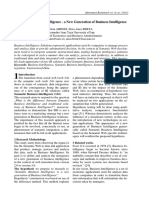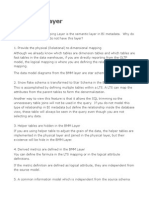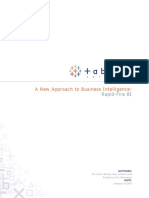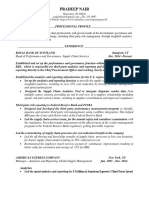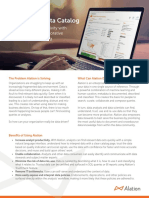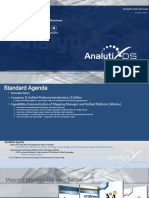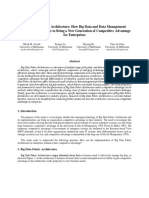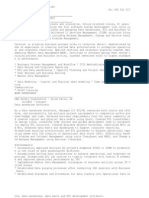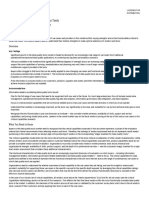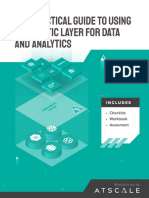0 ratings0% found this document useful (0 votes) 142 views33 pagesSemantic Layer
Copyright
© © All Rights Reserved
We take content rights seriously. If you suspect this is your content,
claim it here.
Available Formats
Download as PDF or read online on Scribd
2anii2s, 1937 Demystifying Semantic Layers for Sel-Servce Analytics
Gartner.
Licensed for Distribution
This research note is restricted to the personal use of Victor Alfonso Flores Cruz
(viaflores@compartamos.com).
Demystifying Semantic Layers for Self-Service Analytics
3 April 2023 - 1D G00783855 - 32 min read
By Christopher Long, Joe Antelmi
Initiatives: Analytics and Artificial Intelligence for Technical Professionals
Data and analytics technical professionals struggle to deliver a universal semantic layer that
balances agility and control in self-service analytics. This research helps technical
professionals review options for deploying semantic layers to enable self-service analytics
Overview
Key Findings
Implementing a universal semantic layer continues to be difficult due to lack of tool
interoperability, poor usability, lagging data governance maturity and organizational inertia
Meanwhile, the pressure from organizations to deliver metric consistency has only grown as
consumption channels for analytics have expanded,
* Widespread self-service analytics development fosters innovation and agility at the expense of
the governance and consistency once provided through centralized semantic layer architectures.
‘* Modern A&Bi tools are expanding access to their modeling layers for more agnostic enterprise
consumption. At the same time, stand-alone semantic layer platforms are extending capabilities
to incorporate metrics store concepts. The expansion of these capabilities blurs the lines for
organizations looking to implement a universal semantic layer.
Recommendations
As a data and analytics technical professional implementing semantic layers, you should:
hntps:nww.gariner.comidocument!42402907ref=solrAllrefvale3854097068 1183�2423, 1937 Demysttving Semantic Layers fr Slt Service Anaytes
* Evaluate and select an appropriate semantic layer for your use case by comparing the benefits,
challenges and representative vendors of the three technical options: data layer semantics,
stand-alone semantic layer, and A&B! tool semantic layer.
* Design a federated analytics architecture. Include a combination of local and global semantic
layer data models based on the use cases, users and desired governance models.
‘* Develop operationalization processes that leverage A&BI tool capabilities for prototype-to-
production semantic layer development. This approach enables business measures, metrics and
data models to originate as A&BI prototypes and go into production with appropriate enterprise-
level support
Comparison
As organizations drive toward the goal of becoming data-driven, the demand for analytics
increases significantly, Semantic layers are often one part of the solution to deliver the needed
analytics across the enterprise. Historically, a centralized, governed semantic layer has been
developed and maintained by IT to support BI and enterprise reporting use cases. However, the
agility demanded by organizations and the capabilities delivered by modern analytics and BI tools
decentralizes this responsibility. No matter how it is implemented, the semantic layer is still an
important element of an analytics architecture. But the classic, centralized semantic layer is no
longer the only option in this space.
Semantic Layer Implementation Options
Organizations taking a deliberate approach to implementing a semantic data layer will find several
primary technology implementation options:
© Data layer semantics
* Stand-alone semantic layer
* Analytics and business intelligence (A&B!) tool semantic layer
These approaches intersect with a variety of locations in the data pipeline where you can place the
semantic layer. This dynamic will be familiar to technical professionals who are deploying a logical
data warehouse (LDW) or lakehouse architecture. Hence, similar guidance applies to the
implementation decisions for semantic layers.
The first two architectural options (below) describe a semantic layer as part of an organization's
modem data architecture, such as an LDW or data fabric. The LDW is designed to satisfy the
majority of analytics requirements. LDWs support a broad set of analytics engines that can serve a
wide variety of users and applications. For that reason, placing the semantic layer in the LDW is.
often optimal. The LDW itself is composed of multiple component parts, making a semantic layer a
hntps:nww.gariner.comidocument!42402907ref=solrAllrefvale3854097068 2133�2423, 1937 Domysttving Semantic Layers for SeltServee Analytics
logical construct of components that are applied based on the specific technologies implemented
For additional information on the LDW construct, see Adopting a Logical Data Warehouse.
Option 1: Data Layer Semantics
This option describes a semantic layer that is built as an extension of data services within the data
layer. Artifacts in this scenario may be made up of a variety of data marts, views (including
materialized views), and online analytical processing (OLAP) models. They are presented as the
connection point for analytics developers to link with source data, This manifestation of the
semantic layer may not always appear to be a single, universal layer due to the potential for
random asset development.
Option 2: Stand-Alone Semantic Layer
This option describes a semantic layer that exists as its own architectural element within the data
and analytics stack. It is placed between the source data and consumption layers. In this
architectural pattern, the tool used to build the semantic layer obscures the source data from
analytics developers and consumers and becomes the primary connection point for analytical
source data. Depending on the technology implemented, stand-alone semantic layers may
manifest in a couple of ways:
* As data virtualization platforms, where source data largely stays in place
* As an abstraction layer, caching data for analytical usage separate from the source
Option 3: A&B! Tool Semantic Layer
This option describes a semantic layer with a local, optimized data store in the A&BI tools
implemented. Because of its location inside an A&BI application, itis likely to be a siloed solution.
Many organizations employ multiple A&B! tools for a variety of reasons, including
* By design to take advantage of distinct capabilities within BI tools
* Growth of the organization through acquisition where the acquired company uses a different
A&B! solution
* Business unit autonomy to purchase their own A&B! solutions
While multiple tools can bring agility to business user development, they can also make analytical
definitions more fragmented throughout the organization. Early reporting tools that implemented
semantic layers were very siloed. And while modern A&BI tools allow for greater sharing between
developer users, the application silo effect is still quite prevalent.
hntps:nww.gariner.comidocument!42402907ref=solrAllrefvale3854097068 3133�2anii2s, 1937
Demystifying Semantic Layers for Sel-Servce Analytics
Table 1 compares the characteristics of the different types of semantic layers
Table 1: Common Semantic Layer Implementations
PeTCn yg
RU
ee ead
eae Cg
ea
ee ey
Common
Features
Developer
Roles
Governance
Localization
Key
‘Strengths
Is an extension
of data store
capabilities
Sits at the edge
of the data layer
May include
views (including
materialized),
data marts and
graphs
Data engineers
Centralized
Is highly
governed
Leverages in-
house
technology and
skills
Can deliver high
volumes of data
to many
concurrent
users
Is an independent
platform solution
Sits between the data
and consumption
layers
May include
virtualization,
abstraction and data
lake enablement
Date engineers
Centralized
Is well-governed
Serves as a
centralized source for
analytical modeling
and metrics
Connects with diverse
data formats across
varying platforms
Is a Bl tool
capability
Is part of the
analytics
consumption layer
Includes cirect
query and
ingestiontype
models
Business analysts and
data analysts
Distributed
Enables flexible
and agile
implementation
and development
Democratizes
analytics
development
» Reduces time to.
insight
htps:nww.garner.comidocument#42402907ref=selAllrefval-3854097068
4133�2423, 1937 Demystifying Semantic Layers for Selt-Servce Analytics
ETP EZ RCT PLA Teo
Rd Ua Cd Reed
Key « Ishighly reliant «Involves IT-heaw + Is less governed
Challenges on central data development and + Offers inconsistent
engineering implementation development and
resources «Is traditionally not deployment of
+ Isslowto designed to support analytical models
change data science and and metrics
«Has limited mactine leering » Isoften isolate
capabilities with (SML) sap within the vendor
unstructured integrated apolication stack
data use cases
+ Introduces another
expensive layer to the
data and analytics
solution
Example IBM, Oracle, SAP, Apache Druid, Apache MicroStrategy,
Vendors Snowflake, Pinot, AtScale, Pyramid Analytics,
Teradata ClickHouse, Data lik, Salesforce
Virtuality, dbt, Denodo, (Tableau), Sisense,
Dremio, Kyligence, Kyvos ThoughtSpot
Insights, Zetaris
Note:
* Major vendors, including Amazon, Google, Microsoft, Oracle and SAP, offer capabilities to support
‘semantic layers in multiple architectural patterns.
‘Source: Gartner (April 2023)
The remainder of this document will:
* Provide background on semantic layer concepts
‘* Compare the three types of semantic layers
© Provide guidance on choosing the right type of semantic layer for your needs
Analysis
hntps:nww.gariner.comidocument!42402907ref=solrAllrefvale3854097068 5133�2423, 1937 Demysttving Semantic Layers fr Slt Service Anaytes
The efforts made by organizations to become data-driven often push the resource limits of what
central data teams are able or willing to provide for A&BI reporting. Many data and analytics teams
are overwhelmed by requests for related analytical deliverables, In response, many organizations
deploy self-service A&B! tools to deliver the agility and flexibility that traditional (centralized) A&BI
development does not provide for.
The problem is that self-service A&BI tools (including their related semantic modeling capabilities)
often turn a once-governed data environment into an uncontrolled, fragmented and inconsistent
environment. This fragmented environment creates risk in decision making and breeds loss of
trust by end users, The need for consistency in business language, analytics calculations,
modeling and representation remains a key focus today as organizations strive to become data-
driven.
Defini
n of “Self-Service” in This Research
Self-service, generally provided through modern A&Bl tools, can be divided into two primary
categories:
* Self-service data prep: The capabilities and processes that enable data scientists and business
users to shape and cleanse data for further analysis. Often, this process results in tables that are
shared across multiple analyses.
« Self-service analytics: The capabilities and features that allow analysts and business users to
connect and model data for analysis, without relying on IT or a central developer resource. These
models can become part of an organization's semantic layer.
For the purposes of this research, we will discuss self-service analytics only and refer to it broadly
as “self-service”
Today's data and analytics technical professionals are challenged to deliver data and analytics
solutions that adhere to the following general principles:
* Outcome-oriented: Aligns to the broader organization's goals
* Valuable: Provides a benefit to users (e.g,, is accessible to a larger population of users, is more
flexible, provides more sophisticated analytics or is more affordable)
+ Easy to learn: Is intuitive to grasp, with training resources available
hntps:nww.gariner.comidocument!42402907ref=solrAllrefvale3854097068 6133�2423, 1937 Domysttving Semantic Layers for SeltServee Analytics
* Available and reusable: Is easily accessed, embedded in applications and workflows, and
reusable by multiple systems and users
* Safe and trusted:
‘© Supports governance policy
* Includes sophisticated identity, access and security management
« Is quality-controlled, regulatory-compliant, and delivered by a performant, reliable platform
However, delivering on all of these principles is not easy. And historically, an IT-built semantic layer
was a big part of the solution. But organizations struggle to balance analytics development agility
with control in order to deliver valuable outcomes to a diverse set of users
Business units are focused on delivering value in the form of fast, agile analytics in their silos. In
the process, they often undermine broader organizational goals for data consistency and a shared
set of key performance indicators (KPIs). By contrast, IT departments are occupied with furthering
organizational goals for trusted, safe, IT-led data management. Therefore, they don't provide
business units with the data or the analytics capabilities that they need in a timely fashion. These
competing objectives have spurred a never-ending debate between control and freedom (see
Figure 1).
Download All Graphics in This Material +
hntps:nww.gariner.comidocument!42402907ref=solrAllrefvale3854097068 7133�2423, 1937 Domysttving Semantic Layers for SeltServee Analytics
Figure 1: The Never-Ending Debate Between Control and Freedom +
Resolve the Never-Ending Debate Between Control and Freedom
Consistency Autonomy.
Share Best Practice Agility
Consensus Innovation
We must create a data architecture, organizational model,
and governance framework that delivers the benefits of both.
Gartner.
Because modern tools and use cases offer diverse ways of implementing
semantic layers, organizations’ views on the ideal semantic layer must
evolve.
Background on Semantic Layers
What Is a Semantic Layer?
Originally introduced as a term in 1991, a semantic layer is a business representation of data. It
provides a consistent, unified view of — and access to — organizational data in common business
terms. However, the concept of a semantic layer has existed as long as organizations have tried to
model and deliver data in end-user terms.
Regardless of how or where a semantic layer is implemented, it should be consumption-tool-
agnostic and provide the following core functions:
* A translation of the underlying database structures into business-user-oriented terms and
constructs.
‘* Views of data elements that are intuitive to business users.
hntps:nww.gariner.comidocument!42402907ref=solrAllrefvale3854097068 8133�2anii2s, 1937 Demystifying Semantic Layers for Sel-Servce Analytics
«The opportunity to rename data elements so that they make sense to business users.
* An interface to hold business descriptions of data elements.
‘* Amechanism to define and store calculations and business rules.
‘* The ability to apply rules and access privileges to KPIs and datasets. (The semantic layer is a
junction for role-based access control and auditing.)
With these functions in mind, semantic layers are built upon multiple foundational components, as
shown in Figure 2.
Figure 2: Semantic Layer Components +
Semantic Layer Components
Peay BES oSe
B) vata Models
a
Creme
34+ Collection offConnection to Data
Gartner
Although the broad ambition of the universal semantic layer remains unfulfilled, it is important to
understand where the semantic layer has come from and where it sits in today's modern D&A
architecture. The following section outlines the history of the semantic layer and the emerging
trends data and analytics technical professionals should be aware of.
How Has the Semantic Layer Evolved?
As noted, the concept of the semantic layer is not a new phenomenon and predates the
implementation of the enterprise data warehouse commonly found today. Over time, the drive for
agllity and the rise of self-service capabilities started to overshadow the use of centrally managed
semantic layers. Figure 3 shows this movement. Today, we see a convergence of capabilities
between independent semantic layer offerings and self-service BI tools.
hntps:nww.gariner.comidocument!42402907ref=solrAllrefvale3854097068 9133�2423, 1937 Domysttving Semantic Layers for SeltServee Analytics
Figure 3: Semantic Layer Journey +
Semantic Layer Journey
Illustrative
a I
z z
i i
£ e
é z
j i
i ‘coma §
| Covered
: } SettSerion
5 | (Federated)
2) | Rrchectre |B
7 i 5
a i §
Timeline 88 1980 2000 wwe 2020 6
Data
Architectures
Emergence of the LW Conceptual Architecture
792855,¢
Gartner
The drive toward this convergence of capabilities has several prevailing themes
* Organizations’ demands to balance governance and agility: Organizations that adopted self-
service — whether organically or as a reaction to the inflexibility of IT-controlled semantic layers
—find themselves straddled with mounting technical debt to maintain fractured views of
metrics. They are looking for some enterprise level of governance to guide further development.
* Organizations’ increased demands for integrated analytics: The growing demand for analytics
across use cases, including data science and machine learning (DSML) and integrated
applications, has caused many organizations to build dedicated pipelines to serve these needs.
Both traditional and self-service semantic models generally have not supported these use
cases.
hntps:nww.gariner.comidocument!42402907ref=solrAllrefvale3854097068 10133

